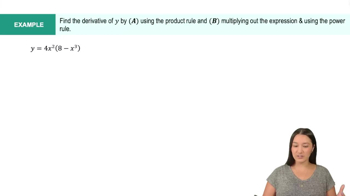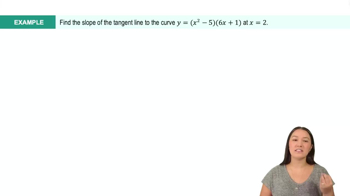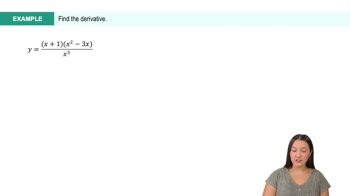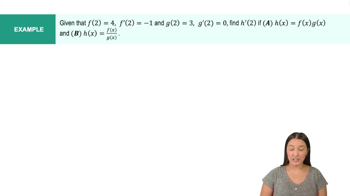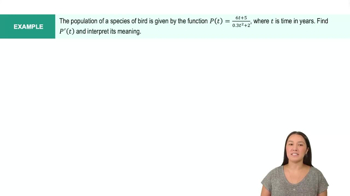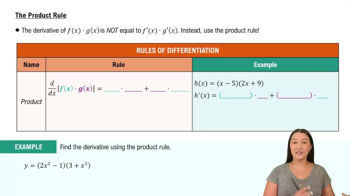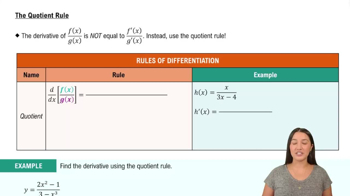Table of contents
- 0. Functions7h 52m
- Introduction to Functions16m
- Piecewise Functions10m
- Properties of Functions9m
- Common Functions1h 8m
- Transformations5m
- Combining Functions27m
- Exponent rules32m
- Exponential Functions28m
- Logarithmic Functions24m
- Properties of Logarithms34m
- Exponential & Logarithmic Equations35m
- Introduction to Trigonometric Functions38m
- Graphs of Trigonometric Functions44m
- Trigonometric Identities47m
- Inverse Trigonometric Functions48m
- 1. Limits and Continuity2h 2m
- 2. Intro to Derivatives1h 33m
- 3. Techniques of Differentiation3h 18m
- 4. Applications of Derivatives2h 38m
- 5. Graphical Applications of Derivatives6h 2m
- 6. Derivatives of Inverse, Exponential, & Logarithmic Functions2h 37m
- 7. Antiderivatives & Indefinite Integrals1h 26m
- 8. Definite Integrals4h 44m
- 9. Graphical Applications of Integrals2h 27m
- 10. Physics Applications of Integrals 2h 22m
3. Techniques of Differentiation
Product and Quotient Rules
Problem 3.8.63c
Textbook Question
Witch of Agnesi Let y(x²+4)=8 (see figure). <IMAGE>
c. Solve the equation y(x²+4)=8 for y to find an explicit expression for y and then calculate dy/dx.
 Verified step by step guidance
Verified step by step guidance1
Start by isolating y in the equation y(x² + 4) = 8. Divide both sides by (x² + 4) to get y = 8 / (x² + 4).
Now that you have y expressed explicitly as y = 8 / (x² + 4), the next step is to find the derivative dy/dx.
To find dy/dx, use the quotient rule for differentiation, which states that if you have a function in the form of u/v, then the derivative is (v * du/dx - u * dv/dx) / v².
In this case, let u = 8 and v = x² + 4. The derivative of u, du/dx, is 0 since 8 is a constant. The derivative of v, dv/dx, is 2x.
Apply the quotient rule: dy/dx = ((x² + 4) * 0 - 8 * 2x) / (x² + 4)². Simplify the expression to find the derivative dy/dx.
 Verified video answer for a similar problem:
Verified video answer for a similar problem:This video solution was recommended by our tutors as helpful for the problem above
Video duration:
4mPlay a video:
Was this helpful?
Key Concepts
Here are the essential concepts you must grasp in order to answer the question correctly.
Implicit Function
An implicit function is a relation defined by an equation involving both dependent and independent variables, where the dependent variable is not isolated. In the context of the given equation y(x² + 4) = 8, y is expressed in terms of x, but not explicitly. Understanding how to manipulate such equations is crucial for solving for y.
Recommended video:
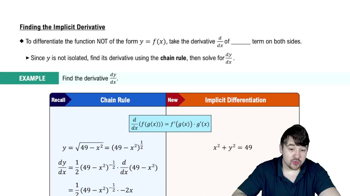
Finding The Implicit Derivative
Differentiation
Differentiation is the process of finding the derivative of a function, which represents the rate of change of the function with respect to its variable. In this case, calculating dy/dx involves applying the rules of differentiation to the implicit function derived from y(x² + 4) = 8. Mastery of differentiation techniques, such as the product rule, is essential for this step.
Recommended video:

Finding Differentials
Witch of Agnesi
The Witch of Agnesi is a specific type of curve defined by the equation y = 8/(x² + 4), which is derived from the original equation by isolating y. This curve is notable in calculus for its properties and applications in various mathematical contexts. Understanding its shape and behavior helps in visualizing the results of differentiation and integration related to the curve.
Related Videos
Related Practice



